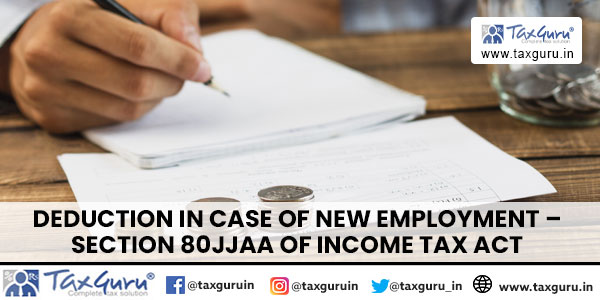For the Purpose to Increase Employment Opportunities and incentivize job creation in India, the GOI has introduced various measures aimed at encouraging business to expand their workforce.
One of Such measure is Section 80JJAA Of Income Tax Act, which provides a significant benefit to the employers who comply with the provisions of this section.
Note: Deduction u/s 80JJAA is available to an assessee irrespective of the regime under which he pays tax.
1. Conditions to be fulfilled
- The business carried on by assessee should not be formed by splitting up, or the reconstruction, of an existing business
- The business must not be acquired by way of transfer or as a result of any business reorganisation
- Applicability Of section 44AB(Mandatory Tax Audit) – any assessee to whom section 44AB applies means report of the accountant, giving the prescribed particulars must be furnished before 30th September (specified date referred in section 44AB)
2. Period of Deduction
- Deduction is allowed for 3 Assessment year including the assessment year in which such employment is provided.
For P.Y. 2024-25, Deduction will be for A.Y. 2025-26, 2026-27, 2027-28
3. Quantum of Deduction
- Deduction shall be allowed equal to 30% of Additional Employee Cost incurred in the course of such business in the previous year.

Understanding Additional Employee , Additional Employee cost and Emoluments –
1. ADDITIONAL EMPLOYEE – means an employee who has been employed during the previous year and whose employment has the effect of increasing the total number of employees employed by the employer as on the last day of the preceding year but does not include:-
- an employee whose total Emoluments > ₹25000 per month or
- an employee for whom entire contribution is paid by GOI or
- who does not participate in RPF
- an employee employed for less than 240 days in the P.Y. and in case of an assessee engaged in business of manufacturing of apparel or
footwear or leather products less than 150 days in the P.Y.
Note – if an employee is employed for less than 240 or 150 days in the previous year but is employed for more than 240 or 150 as the case may be, in the immediately succeeding year, he shall be deemed to employed in the succeeding year. Accordingly, the employee will come under the definition of “Additional Employee”.
The assessee shall be required to submit a certificate from a CA in form no. 10DA certifying the amount of deduction claimed.
2. ADDITIONAL EMPLOYEE COST – Total emoluments paid or payable during the year to such additional employee employed.
In case of an existing business – The additional employee shall be nil if there is no increase in the number of employee.
In the first year of a new business – The Emoluments paid or payable to the employees shall be deemed to be the additional employee cost.
3. EMOLUMENTS – any sum paid or payable to an employee in lieu of his employment but does not include –
- any contribution by employer any pension fund or provident fund or any other fund; and
- any lump-sum amount paid or payable to an employee at termination of his service, such as gratuity, leave encashment, commutation of pension etc,
Impact and Conclusion – The deduction provided under the section encourages business to hire more employees. It stimulates economic growth and reduce employment rate.
Conclusion: Section 80JJAA of the Income Tax Act not only provides tax benefits to employers but also plays a pivotal role in addressing unemployment challenges. By encouraging businesses to hire more employees, this initiative supports economic development while aligning with national employment objectives. Understanding and leveraging these provisions can significantly benefit businesses in maximizing their interests and contributing to the nation’s economic growth.




